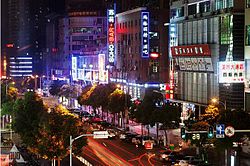- Entrance of the Former Residence of Lei Feng.
- The Lushan Temple in Mount Yuelu.
- The Kaifu Temple in Kaifu District.
Secondary industry
Engineering machinery industry


The engineering machinery industry of Changsha started from the end of the 1970s. With the rapid development of more than 30 years and led by the leading enterprise like Zoomlion, Sany Group, Sunward Intelligent Equipment (Sunward UAV), the industry keeps expanding. The overall economic performance of the industry is above the average level of China. In 2014, the output of industrial enterprises above designated size accumulated to RMB 180,700,000,000 and it became the biggest engineering machinery production and manufacturing base that had the capacity of independent R&D and manufacturing of high-end and large-size products. So far, over 400 models of products that fell in over 100 sub-categories and 12 categories have been produced by the engineering machinery industry of Changsha, accounting for 70% of all varieties of the national engineering machinery. Many enterprises, represented by Zoomlion, Sany Group, Sunward Intelligent Equipment and others, took an active stance in expanding their overseas business and speeding up overseas investment, merger and acquisition, and gradually became large-scale engineering machinery manufacturing enterprise groups with world-class competitiveness.
Electronic information industry

Changsha has brought together over 1800 electronic information enterprises. In 2014, the output of Changsha's electronic information industry was RMB 150,000,000,000, a rise of 28% year-on-year. Over 10 Fortune Global 500 enterprises like Microsoft, IBM, Motorola, Cisco, Dell, Ericsson, Foxconn, Hitachi and Harris have gathered here. A wide range of industry (represented by 58 daojia, Talkweb, Longtu Game and Shanlingyuanshang), a Beidou satellite application industry (represented by Greatwall Information Industry, Hangtiandianzi, Garland Gai & Tech), an integrated circuit industry (represented by No. 48 Institute of CETC, Goke Microelectronics, Jingjia Micro, Zhonghui Microelectronics and Ronghe Microelectronics), an intelligent terminal industry (represented by Lens Technology, Newsmy, Success Electronics and Jtouch), and a modern information service industry (represented by Greon Apple Pata Center, Yunqi Network and China Mobile E-commerce).
Material industry
The overall level of Changsha's material disciplinary cluster ranks among the top of China and it enjoys the reputation of "Changsha school of Metallic Materials" in international academic circles. It has 3 national key material laboratories, 4 state-level engineering technology centers, 1 state-level engineering research center, national base for achievement transformation and industrialization of new materials in China. So far, 5 industry chains oriented by nonferrous material, fine chemical material and green construction material and featured by energy storage material and carbon material have come into being: Presently, there are over 450 enterprises above designated size, which mainly gathered at Changsha High-Tech Industrial Development Zone, Ningxiang Economic and Technological Development Zone, Wangcheng Economic and Technological Development Zone and other industry parks. In 2014, the total value of output amounted to RMB 190,000,000,000. A wide range of the leading enterprises, featured by different scales and with output value of RMB 10,000,000,000, RMB 5,000,000,000, RMB 3,000,000,000 and RMB 1,000,000,000, has preliminary taken shape.
Automobile and parts industry
Changsha's automotive industry started from the 1960s and when it came into the 21st century, Changsha has gradually become one of the important automobile production bases of China. By 2014, there have been over 100 enterprises above designated size specialized in automobile and spare parts (of which 10 enterprises engaged in vehicle production), and vehicle production covered 6 categories: car, light-mid-heavy duty truck, off-road vehicle, special-purpose vehicle, passenger car and new energy automobile. The automobile industry cluster based on "Two districts, two parks one corridor" and centered on the 6 categories of vehicles preliminarily took shape. Changsha now has become the first city of China that has the capacity of manufacturing all categories of automobiles. According to statistics, in 2014, the automobile industry of the city kept a stable growth.
Biopharmaceutical industry

After years of development and agglomeration, Changsha has developed Liuyang Economic and Technological Development Zone, Changsha High-Tech Industrial Development Zone and Jinxia High-Tech Industrial Development Zone for its biopharmaceutical industry, introducing and fostering a great batch of growth-type enterprises featuring promising market prospect, high technology and strong momentum of development including Hunan Jiuzhitang Co., Ltd, Hunan Jiudian Co., Ltd and Ang Pharmace-utical Co., Ltd.
The capacity of Changsha to support the industry has been greatly enhanced. Changsha's biopharmaceutical industry is composed of modern Chinese medicine, basic engineeringandmodern seeding. The modern Chinese medicine processing technology and modern seeding technology are among the leading ones of the central region. In 2014, there are over 170 biopharmaceutical manufacturing enterprises in Changsha, of which 66 enterprises were above designated size, 4 were listed ones and 11 had an output value of over RMB 100,000,000. A total of 1504 drug varieties were produced.
Foodstuff industry

As the new-type industrialization process moves forward continuously, Changsha's foodstuff and tobacco industry has taken shape, developed and gradually become a dominant industry of Changsha. So far, four major clusters: Ningxiang, Liuyang, Wangcheng District and Longping High-Tech Industrial Development Zone have taken shape preliminary, getting together 12 sub-industries including tobacco product, dairy product, meat processing, grain and oil processing, seasoning, wines, drinks, tea, snack food, health food, food processing and other agricultural and sideline product processing sectors. In 2014, there are 271 food production enterprises above designated size, of which 136 enterprises had an annual.value of production over RMB 100,000,000 and 8 enterprises exceeded RMB 1,000,000,000. Its total value of industrial output amounted to RMB 151,000,000,000, a rise of 10.7% and it realized an industrial added value of RMB 83,500,000,000, up 8.7%.










